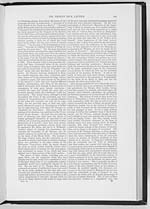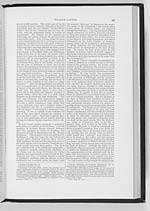466
Lochindhu and the Wolf are heart-stirring captivat-
ing romances. In scenic description and delineation
of events Sir Thomas has approached the nearest to
Scott of all the ambitious imitators of the "Great
Unknown" of the period. But it is in individuality
of character that he chiefly fails, and his knights,
like the brave Gyas, and the brave Cloanthes, are
little more than facsimiles of each other. They
have all the same complement of thews and bones,
and are equally prompt to use them; and they only
differ by virtue of the scenery with which they are
surrounded, and the historical actions of which they
form a part.
But of all the works which Sir Thomas Dick
Lauder has produced, that entitled The Moray Floods
in 1829, is perhaps the one by which he will continue
to be best appreciated. He had himself not only
been an eye-witness of these tremendous inundations,
but an active philanthropist in the relief of those
who had been ruined by the havoc; and the account
which he wrote of the event will long be prized by
the lovers of vigorous writing, and vivid, poetical,
and truthful description. Another descriptive work
which he produced, commemorative of a great
national event, was the Queen's Visit to Scotland in
1842. But reverting during this long interval to
that kind of study which gave full scope to his ima-
gination, as well as brought the varied resources of
his experience and observation into complete act and
use, he published his "Highland Rambles, with Long
Tales to Shorten the Way;" a work which, indepen-
dently of its attractive narratives, is an interesting
memorial of the Celtic character, manners, and super-
stitions, and the intimate knowledge which he had
acquired of them. Besides these original produc-
tions, he edited Gilpin's Forest Scenery, and Sir Uve-
dale Price on the Picturesque. To the latest period
of his life, also, he continued to be a contributor to
our periodicals, in which his articles, chiefly consist-
ing of Highland and Lowland tales and sketches,
were always gladly welcomed by the reading public.
These, we doubt not, if collected and published in a
separate work, would soon become the most popular
of his literary productions.
From the foregoing account it might be supposed
that the life of Sir Thomas had been chiefly spent
in the study; and that when he emerged into society,
it was rather for the purpose of enjoying relief, than
taking an active part in its occupations. But, on
the contrary, he was an industrious, public-spirited
man, fully conscious of the duties of his position, and
indefatigable in promoting the best interests of his
country. In this way he bestirred himself in the
great political questions of the day, and was one of
the most active promoters in Scotland of the reform
bill. In 1839 he was appointed secretary to the
Board of Scottish Manufactures, which was soon
afterwards united by the lords of the treasury to
the Board of White Herring Fishery; and as secre-
tary of both his labours were sufficiently diversified,
as well as widely distinguished from each other. It
was a Janus-like office, that required a double and
opposite inspection�or rather, a planting of "one
foot on sea and one on shore," like the very personi-
fication of an inconstant man, which Shakspeare's
ditty so touchingly describes. But faithfully and
ably were these opposite functions discharged. In
his department of manufactures Sir Thomas quickly
perceived that, in consequence of the extension of
our commercial and manufacturing operations, the
original purpose for which the Scottish board had
been created was in a considerable degree superseded.
He therefore endeavoured to restore it to full effi-
ciency, by adapting it to the progress of modern im-
provement; and for this purpose he proposed that
its surplus funds should be employed in the exten-
sion of schools for teaching pattern-drawing. On
the proposal being sanctioned, he carried it into
execution so zealously, that artistic taste was diffused
anew throughout our manufactories of fanciful design,
and a love of the fine arts promoted among those
classes that had hitherto been contented with humble
imitations of foreign excellence. His task as secre-
tary of the White Herring Fishery Board was ful-
filled with equal diligence; and as one of its duties
was an annual voyage round the British coast, and
an examination of its places of export, he turned the
experience he thus acquired to good account, by
aiding in the supply of materials for a narrative of
the voyage in 1842, which was written by Mr. Wilson,
the naturalist, who accompanied him. He also
wrote several books of directions for the taking and
curing of herring, cod, ling, tusk, and other fish,
which were translated into Gaelic for the instruction
of the Highlanders. While so much was accom-
plished in the course of his professional duties, he
was not neglectful of those public movements which
concerned the general weal, and from which he
might have excused himself under the plea of a
press of occupation elsewhere. Among these public-
spirited exertions we can only allude in passing to
the interest he took in the proceedings of the original
Scott Monument Committee, of which he was one
of the most active agents�and his efforts for the
construction of the Queen's Drive round Arthur's
Seat and Salisbury Crags, already become the fairest
ornament of the fairest of European cities.
Such was the life of Sir Thomas Dick Lauder to
the close�a twofold life of diligent study and active
exertion, in each of which he was a benefactor to
society, and a distinguished ornament of his country;
while several of his writings, translated into the
French and German languages, acquired for him a
European reputation. His private worth and amenity
of character had endeared him also to the learned
and talented, so that scholars, authors, and artists
sought his society, and were benefited by his counsel
and conversation. Even strangers were arrested, as
he passed along the streets of Edinburgh, by the
sight of his noble stately form, long white locks,
and remarkably handsome expressive countenance,
and felt convinced at once that this man must be some
one as much distinguished above his fellows by in-
tellectual as by personal superiority. This round
of activity was only interrupted by his last illness,
which was occasioned by a tumour on the spine, that
for fifteen months incapacitated him for attendance
at the Board of Trustees for Manufactures, &c., and
finally obliged him to lay aside a work descriptive
of the rivers of Scotland, of which part had already
appeared in a serial form in Tait's Magazine. He
died at his residence called the Grange, near Edin-
burgh, on the 29th May, 1848, at the age of sixty-four.
Independently of the offices we have mentioned,
Sir Thomas held that of deputy-lieutenant of the
county of Haddington; he was also a fellow of the
Royal Society of Edinburgh. He was survived by
two sons and six daughters, and succeeded in the
baronetcy by his eldest son, Captain Dick, who, a
short time previously, had retired from the army after
fourteen years of military service as an officer in the
East India Company.
LAUDER, WILLIAM, a man renowned in literary
history for having turned superior talents, and very
high classical acquirements, to an attempt to defraud
Milton of his fame. Of the period of his birth, which
has escaped the patient investigation of Chalmers,

![]() Universal Viewer |
Universal Viewer | ![]() Mirador |
Large image | Transcription
Mirador |
Large image | Transcription
![]()

